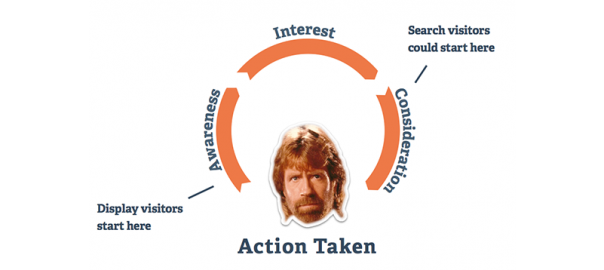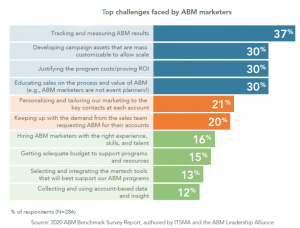
The first steps of setting up your online marketing campaign are critical. Not all leads are created equal, and not all viewers are interested. It’s important to take that into consideration when deciding who you want to reach and how.
When it comes to online advertising, many choose to invest in either search or display networks. But how do you know which is best for you? There are many key differences between the two, as well as many advantages and disadvantages to keep in mind when crafting your marketing campaign.
What Are Search Ads?
Running ads on a search engine network is the most common, well-known form of PPC advertising. They’re text ads that show above and next to the organic results on a search engine results page. You’ll often see them with ad extensions, like customer ratings and click to call buttons.
Here’s an example of search ads that appeared when I searched for “women’s sweaters.”
When a user completes a search on a search engine – like Google, Bing, or Yahoo – their keywords trigger certain ads. Even the same search on a different search engine yields different ads. Look what happens when you search for “women’s sweater’s” on AOL. Search ads use the keywords or phrases in a search query to best match your product or service with what the user’s searching for. The goal is to get the user to click on your ad, taking them one step closer to buying from you. Paid ads are often more robust than organic search results, and allow for additional links, phone numbers, and ad extensions
Search ads use the keywords or phrases in a search query to best match your product or service with what the user’s searching for. The goal is to get the user to click on your ad, taking them one step closer to buying from you. Paid ads are often more robust than organic search results, and allow for additional links, phone numbers, and ad extensions
What Are Display Ads?
Display ads are, simply put, more graphical than just plain text ads. Users who see display ads aren’t actively searching. Instead, they’re browsing the internet for the morning news, watching a new movie trailer, or trolling sites for the latest gossip. This means that ads have to be particularly attractive in order to gain the user’s attention.
Display ads can be placed on relevant websites to target people who may not be aware of your brand, but might be interested in your product or service. Or, they can be used to retarget potential customers who have already shown an interest, but may not have made a purchase. These ads can be text, but usually they’re images, rich media, or video ads — like the ones you see before a YouTube clip, or the colorful banners running across the top of a web page.
These ads can be text, but usually they’re images, rich media, or video ads — like the ones you see before a YouTube clip, or the colorful banners running across the top of a web page.
Display networks give advertisers the opportunity to scatter their ads among the millions of sites that are browsed each day. The Google Display Network alone reaches over 90% of global internet users. These networks have amazing reach, including news sites, weather sites, YouTube, blogs, and mobile apps.
Why Are They Effective?
Search ads target an active searcher, and therefore drive more conversions than display campaigns. It’s about providing the answer someone is actively seeking or fulfilling a current need.
Display ads are effective for remarketing previous leads or customers, as well as building brand awareness and trust. The ad below is an example of JCPenney remarketing me. After clicking on their search ad, I see this while checking Accuweather:
 Here, JCPenney is giving me a visually pleasing reminder that I was interested in their cardigans.
Here, JCPenney is giving me a visually pleasing reminder that I was interested in their cardigans.
While display ads don’t usually reap as many clicks as search ads, you may win out in the long run with more clicks on organic search ads. If someone knows about your brand, they can search for it specifically.
In fact, a study by the Harvard Business School found that exposure to a display ad increased the percentage of search ad conversions by 15-20%. People are more likely to buy from a company that’s familiar to them. So while you may not see the success of display ads in the clicks they get, you’ll see it in the increased search queries for your brand or product.
Which Should You Choose?
The key difference in the purpose of each type is the audience’s disposition. The user behavior differs when the audience viewing each type of ad is at different stages in the buyer’s journey. As mentioned above, search ads are shown to active searchers while display ads are shown to more passive browsers.
Source: Unbounce
A search campaign is ideal if you have a limited budget, you’re newer to the advertising world, or you sell a product or service that usually comes with an immediate need (like a plumber). In this case, you’ll want your ads to appear next to search results to show to people who are already in consideration and want to take action.
A display network campaign can work well if you have a lengthy sales process. It’s also a great way to battle cart abandonment, by reminding customers of products they already showed interest in. It’s also good for advertisers who sell visually appealing products, such as clothing or shoes; something that you’d want to see before you buy.
Why Not Use Both?
You don’t have to choose one over the other. Let’s say you want to target people actively searching for a new pair of snow boots. But you also want to build brand awareness with casual browsers, letting them know your brand can be trusted to provide quality and style, too. In this case, implement both search and display advertising. Target the consumers who need boots, and increase brand awareness with others who may purchase them at a later date.
It’s also important to measure the success of each campaign separately. It can be hard to measure the success of display campaigns since they’re about brand awareness and not necessarily clicks. However, you may want to master search advertising and then move on to display, since it can boost visibility. Display advertising can be more difficult to master.
While the benefits for both differ, it’s possible to run both at the same time as long as your company is making sure to treat and analyze each campaign separately.
Digital & Social Articles on Business 2 Community(44)







